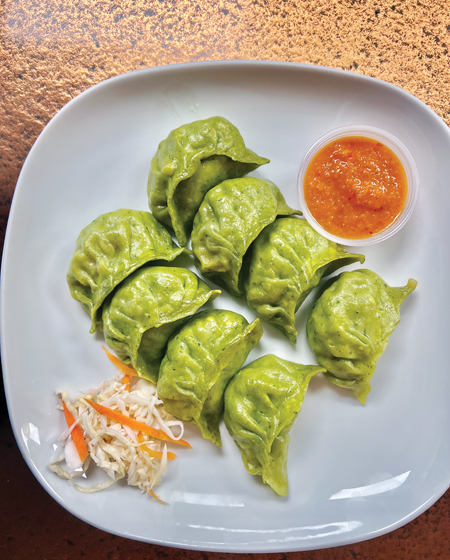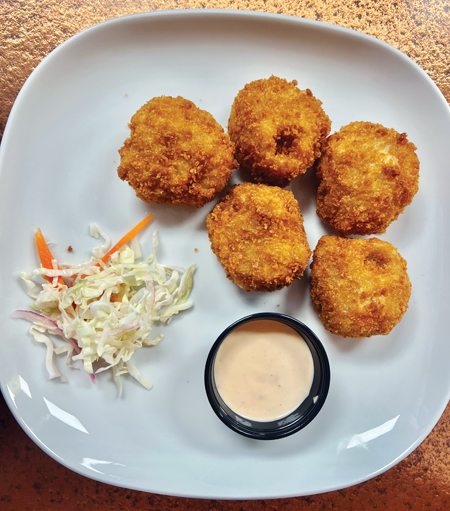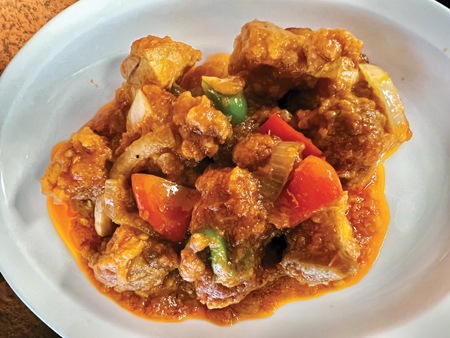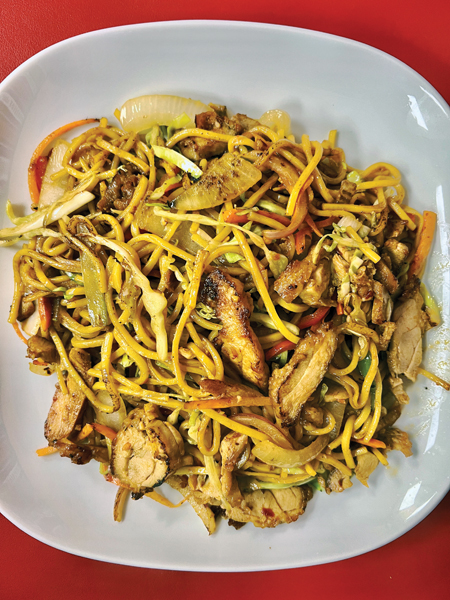Khabar Magazine. Sept 2022 print.
Devour soft, fluffy, steaming momos stuffed with minced chicken and a fiery chili dipping sauce. Pick them off paper plates while looking over a scenic backdrop of snow-covered mountain ranges. You may think you are somewhere at a hill station in the Himalayas,but you are actually right here in the city of Smyrna.
Tucked away in a residential neighborhood between Windy Hill Road and Atlanta Road, Himalayan Kitchen is a small Tibetan restaurant where you can get authentic flavors from the country. The restaurant was started by Kalsang Lama—who goes by Kelly—and her chef-cum-business partner Sonam Dhong Dhong. Both Lama and Dhong Dhong were born in Tibet and lived in northern India’s Tibetan settlements in Mussoorie and Dehradun respectively. They later emigrated to the U.S., worked their way up in the restaurant industry, and finally opened their own establishment in December 2019.
For almost three years, Himalayan Kitchen has remained resilient, just like the majestic mountains themselves, overcoming the challenges of a new restaurant and soon after, an unforeseen pandemic. With no advertising or delivery services and a staff of only two people, they survived through what was one of the worst times for the restaurant industry. Loyal patrons, like myself, who craved simple and flavorful home cooking at affordable prices, continued to order takeout as the restaurant closed for dine-in for the majority of its life.
This summer, Lama and Dhong Dhong took a month-long vacation to visit their families in India. When they returned, they reopened the restaurant for dine-in and redecorated the modest 40-seater restaurant with colorful and modern interior. Bright orange walls, colorful tapestry, and copper-top tables, along with Lungdar, the Tibetan peace prayer flags, create a cozy space with balance and harmony. The soft chanting of the Green Tara Mantra in the background adds to the peace and calmness of the space. Large paintings of Dzongs, the Tibetan monasteries, and mountain scenery instantly draw you in to the foot-hills of the Himalayas. Decorative pieces such as the eight auspicious symbols of Tibetan Buddhism, Dranyen, and the Tashi Delek sign which stands for good luck and good health, reinforce the strong roots of the restaurant.

Tibet is a small country bordered by China, Mongolia, Nepal, Bhutan, and India. This proximity lends itself to some overlap in cuisines. Brothy noodle soups, steamed dumplings, and stir-fried noodles can be found in most of these neighboring cuisines, including in Tibet. But Himalayan Kitchen remains authentic to the dishes that the owners grew up eating in their refugee settlements and brings these recipes passed on by their families all the way to Atlanta.
The star attraction on the menu is the Tibetan Momo. The pillow-soft flour dumpling is made in-house from scratch and cooked to perfection. You can order it steamed or deep-fried, stuffed with vegetables, potatoes, or beef or chicken. The all-natural spinach greencolored vegetarian version is not only delicious, but healthy as well. It is filled with soybeans, celery, chives, cabbage, tofu, green onion, red onion, cilantro, ginger, and garlic.

The accompanying dipping sauce is spicy— so tread with caution. Dhong Dhong imports Sichuan peppercorns from India, which he pounds down with tomatoes, onions, and garlic. Specify your preference of medium, mild, or hot and the chef can adjust any dish to suit your palate.
Kelly’s Special Momo is crusted with panko breadcrumbs, and deep fried for an unusual twist that American patrons seem to enjoy. My personal favorite is Butter Curry Momo because it combines the delicate chicken stuffed dumpling with sweet, creamy, and tangy flavors of Indian butter chicken sauce.
For a hearty dish, try Thukpa, also known as Gyathuk, a spicy soup with egg noodles, along with a choice of protein, and lots of vegetables. Chowmein is what is often referred to as Hakka Noodles at Indo-Chinese restaurants. Stir-fried long noodles are loaded with shredded vegetables, thick soy sauce, black pepper, fresh garlic, and chilis. The fresh and flavorful dish reminds me of the popular Chinese food served at street stalls across India.

Another dish that resembles Indo-Chinese cuisine is Fried Rice. Basmati rice is stir-fried with fresh vegetables—zucchini, carrots, tofu, onions, mushrooms, celery, and topped with a choice of tofu, beef, chicken, or shrimp.
The Chef’s Special portion of the menu features “Indian Flavor” which includes spicier items such as Chili Chicken, Chili Fried Fish, and Chili Tofu. Just like in Indo-Chinese cooking, the proteins are dipped in batter and deep fried with pepper, soy, chili, garlic, onions, and scallions.
The owners at Himalayan Kitchen recognize that many of their diners prefer vegetarian or vegan diets. They make eggless homemade noodles and can customize most dishes without meat or eggs. Vegetarians should try Veggie Fried Rice, Veggie Chowmein, and Shabakley, a popular Tibetan street food that resembles a deep-fried patty or empanada.
A refreshing homemade Mango Lassi acts as a sweet pairing and ending to the meal. Himalayan Kitchen currently does not offer any desserts, but plans to introduce some Tibetan sweets in the future.
Whether you decide to dine in or order takeout, you will find service at this neighborhood restaurant to be friendly and hospitable. Lama and Dhong Dhong engage with diverse patrons who enjoy learning about their cuisine, conversing in Tibetan, English, Hindi, Spanish, and many other languages they have picked up on their journey.
~ This article appeared in the September 2022 print issue of Khabar Magazine.